
by Victoria Lucas
Place Number 1: Denver
The neat thing about film festivals is not just being able to see more than one film in a short period of time. It's the gossip, the revelations, the people who show up, some of them onstage. In this case the festival site was Denver, Colorado. Seem an unlikely place for a film festival? But there it was that "7 Faces of Dr. Lao," made last year, enjoyed its first U.S. release on March 18. I went there basically to see that one film, but my ride-sharing friend went to see many. So I saw a little of Denver outside the movie theater. But I'm not here to review Denver.

My mom's postcard—I don't have a camera
Place Number 2: the MGM lot
If you saw my review of Finney's Circus of Dr. Lao back on June 16, 1962 you would know why I went to such (literally) lengths to see this movie. It did not disappoint, but I did object to the interpolations of a soppy romance and a hackneyed Western takeover-the-town plot. The "Circus" was filmed, according to sources, on the MGM back lots, although some of those Culver City hills must be pretty rough if that's so. My theory is that filming on location was out due to the many roles of Tony Randall, who plays Dr. Lao, the Abominable Snowman, Merlin, Apollonius of Tyana, Pan, The Giant Serpent, and Medusa. All those makeup and costume changes (to say nothing of any other cast) must have needed the workshop of famed makeup artist William Tuttle and a large selection of MGM costumes, as well as (not credited) costumer Robert Fuca.

Place Number 3: Chujen, Chu, China

This was the last place Laozi was seen alive (531 BC), if indeed he did live. In the movie, but not the book, the Abalone newspaper editor, Ed, asks where he is from, and after Dr. Lao tells him this place, Ed looks it up (providing an opportunity to see his love Agnes, who in the movie is a librarian as well as a teacher) and confronts Dr. Lao with the news that Chujen no longer exists, so what is going on? So we and Ed see the circus tent and Merlin (not in the book) for the first time. And that provides me with an excuse to tell you the following. The plot of both Finney's story and the film was, very briefly, that the circus comes to town, the town of Abalone, to be exact. But it's not a Barnum & Bailey-type circus. It arrives somehow with, or in the person of, the Chinese legend Laozi (Lao-Tse, Dr. Lao, or as you wish), since in the movie he arrives on a donkey with only a fishbowl and fish, as well as a pipe, which he ignites with his thumb as lighter. It consists of other legends, myths, and gods in—as it were—the flesh. The rest is what happens to, of, with, by, and from the circus and its hawker, guide, medicine man, and (in the movie) magical self, Dr. Lao.

Courtesy of University of Arizona Special Collections
Place Number 4: Abalone, Arizona
MGM's Abalone, understandably, looks just like all those old western towns you see in television shows and movies, more than one horse, but not more than half a dozen, and not more than that many streets. I always thought of Finney's Circus as taking place in the late 1920s, when he began the story while he was still billeted in China by the U.S. Army. But this version of the story takes place in that same smeared-out time zone that westerns always use—somewhere between 1890 and 1910, when record players were known as gramophones, and when men were men and women were uh … unable to take care of ourselves.
Place Number 5: Tucson, Arizona
Many people, including me, think that Abalone, Arizona—the setting of more than one Finney story—was actually Tucson. And there is an "Old Tucson," a movie set just outside Tucson that became a tourist attraction in which the stagecoach gets robbed twice daily. The set really epitomizes that "Old West" stereotype that dominates in "7 Faces." But in desert scenes, saguaro cacti figure heavily in the movie's landscape. Most people don't know that saguaros are not found anywhere but in the Sonoran Desert. There is a certain creep, perhaps a foot or so per year, as the cacti spread around mainly southern Arizona (U.S.) and northern Sonora (Mexico), but at this point they only live in the Southwest, and not on the MGM lot in California. The ones on the MGM lot look pretty strange. I would have said that the cacti were the worst things about the movie, were it not that I realized that their strange appearance (looking like cardboard cutouts) adds to the surreal nature of the film.

A real—not surreal—saguaro cactus near Tucson, Arizona
Place Number 6: Dr. Lao's circus tent
The circus tent of the good doctor is said to be "bigger on the inside than it is on the outside" by one observer in the movie, and indeed it has many twistings and turnings. In fact it is rather like a layered labyrinth and is a remarkable movie set, one of the best inventions of the movie, I think. There is a lair for every beast, a spiel for every part of the tent. Steps up, steps down– Hurry! Hurry!–a very strange circus tent that provides the setting for the fish from Dr. Lao's fishbowl, not in the book, but in the movie an excuse for some animation when it grows to the size of the sea serpent advertised. The book ends with the story of Woldercan (below), but the movie has a showdown with villain Clint Stark's henchmen that burns the tent.
Place Number 7: Woldercan
Woldercan was a city dominated by a vengeful god in Finney's Circus, and now, in the movie, destroyed by improbable cataclysms. In both the movie and the book, Woldercan is shown as if unfolding outside as the rear of the tent rolls up, but in the movie the people of the city look like the people of Abalone, and they are led astray by a man who looks like Stark. In the book they are threatened by starvation and flock to the temple, where a dispute over which virgin to sacrifice leads to the deaths of three people—not the whole city. In the movie the story of Woldercan becomes the turning point in the Stark v. Abalone battle.

The author, courtesy of University of Arizona Special Collections
As I think of it, the movie was funny although not Finney, worth seeing for the performances of Randall and Barbara Eden (Angela), the jokes and pokes at westerns—oh, and don't forget the surrealism. Go see this circus when it comes to town.
And now for a little catalog. Finney put one at the end of his story, so I thought I'd put just a short one in:
Plots & bits interposed in Finney's tale:
- romance of Angela & Ed
- politics of Clint Stark v. Abalone, including meetings, printshop destruction
- Lao's interruption of beating of George who is supposed to be a Navajo (Indians from Northern Arizona) played by a Lakota (Plains) Indian
- inflation of sea monster
- Lao's trick of lighting his thumb
- Lao's trick of speaking any dialect, not just perfect English v. Chinee American stereotypical dialect.
Men-like creatures not in book:
- abominable snowman (screenwriters' solution to the book's Russian v. bear problem)
- Mike (Angela's son)
- Clint Stark
- cowboy muscle and snark
- Merlin the magician (Apollonius was the magician in the book)
- Ed Cunningham (Angela's honey and editor of the newspaper)
Woman-like creatures not in book:
Ending as it began
As for Laozi (not pronounced LOWzee), he was last seen riding into the west, but in the 6th century BC that was on a water buffalo. On the MGM lot in 1963 it was on a donkey, and in the direction of some cardboard saguaros. Or, as the movie's Dr. Lao (pronounced LOW) would say, "Hello. Goodbye. Thank you."

[Come join us at Portal 55, Galactic Journey's real-time lounge! Talk about your favorite SFF, chat with the Traveler and co., relax, sit a spell…]


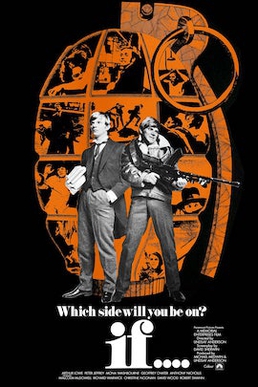

![[August 4, 1967] Bond Movie. James Bond Movie (<i>Casino Royale</i>)](https://galacticjourney.org/wp-content/uploads/2022/08/670427casinoroyale-672x372.jpg)

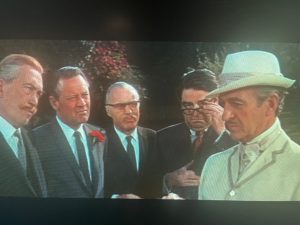 In plot terms, Casino Royale is two almost entirely separate films, tenuously linked by a handful of scenes. The ‘first’ plot features David Niven as a retired, now celibate, British agent named James Bond, who is returned to service when all other agents are being killed off due to their fondness for sex. Bond recruits a new agent, Coop (Terence Cooper), and instigates an anti-sex training programme, thus allowing the movie to have its cake and eat it through sequences of Coop being sexually tempted but boldly resisting. Mata Bond (Bond’s daughter by Mata Hari) is recruited by her father and discovers a plot to auction SMERSH agent Le Chiffre’s collection of blackmail materials to various military forces from across the world, whose senior staff have been photographed in compromising situations.
In plot terms, Casino Royale is two almost entirely separate films, tenuously linked by a handful of scenes. The ‘first’ plot features David Niven as a retired, now celibate, British agent named James Bond, who is returned to service when all other agents are being killed off due to their fondness for sex. Bond recruits a new agent, Coop (Terence Cooper), and instigates an anti-sex training programme, thus allowing the movie to have its cake and eat it through sequences of Coop being sexually tempted but boldly resisting. Mata Bond (Bond’s daughter by Mata Hari) is recruited by her father and discovers a plot to auction SMERSH agent Le Chiffre’s collection of blackmail materials to various military forces from across the world, whose senior staff have been photographed in compromising situations. Meanwhile Mata and Bond travel to Casino Royale, where they discover the mastermind behind SMERSH, Doctor Noah, is in fact Jimmy Bond, Bond’s nephew (Woody Allen), who has become a supervillain through feelings of inadequacy. Noah is tricked into swallowing a pill that turns him into a walking atomic bomb and a free-for-all breaks out in the casino, with invasions by cowboys, Indians, seals, the Keystone Kops, a French legionnaire, and actor George Raft — the whole thing eventually blowing sky-high as the heroes fail to prevent Noah from exploding.
Meanwhile Mata and Bond travel to Casino Royale, where they discover the mastermind behind SMERSH, Doctor Noah, is in fact Jimmy Bond, Bond’s nephew (Woody Allen), who has become a supervillain through feelings of inadequacy. Noah is tricked into swallowing a pill that turns him into a walking atomic bomb and a free-for-all breaks out in the casino, with invasions by cowboys, Indians, seals, the Keystone Kops, a French legionnaire, and actor George Raft — the whole thing eventually blowing sky-high as the heroes fail to prevent Noah from exploding.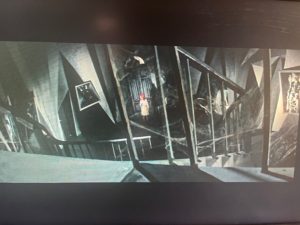 Certain elements of the story are indeed more or less direct spoofs, either of the James Bond franchise itself or of the wider spy series craze. The film starts with a pre-credits sequence which is just a tiny scene of Bond meeting a French agent in a pissoir, simultaneously setting up and destroying expectations of a James Bond-style pre-credits action sequence. Mata Bond’s trip to Germany places her within a stage set straight out of The Cabinet of Doctor Caligari, in a nod to the huge debt the spy film genre owes to Expressionist artform. The supporting cast includes people who’ve either appeared in Bond movies or the many independent television spy series that have cashed in on the Bond craze, notably Ursula Andress but also Vladek Sheybal and promising young character actor Burt Kwouk. As in many spy series, doubles and duplicates turn up frequently. The bizarre conceit of having all the agents, male, female, and, by the end of the adventure, animals, named James Bond/007, can be construed as a sly comment on the fact more than one actor has played Bond, or even a metatextual joke about the proliferation of code-names and numbers in such series. And, of course, the villain is motivated by a sense of personal and sexual inadequacy—what spy series villain isn’t?
Certain elements of the story are indeed more or less direct spoofs, either of the James Bond franchise itself or of the wider spy series craze. The film starts with a pre-credits sequence which is just a tiny scene of Bond meeting a French agent in a pissoir, simultaneously setting up and destroying expectations of a James Bond-style pre-credits action sequence. Mata Bond’s trip to Germany places her within a stage set straight out of The Cabinet of Doctor Caligari, in a nod to the huge debt the spy film genre owes to Expressionist artform. The supporting cast includes people who’ve either appeared in Bond movies or the many independent television spy series that have cashed in on the Bond craze, notably Ursula Andress but also Vladek Sheybal and promising young character actor Burt Kwouk. As in many spy series, doubles and duplicates turn up frequently. The bizarre conceit of having all the agents, male, female, and, by the end of the adventure, animals, named James Bond/007, can be construed as a sly comment on the fact more than one actor has played Bond, or even a metatextual joke about the proliferation of code-names and numbers in such series. And, of course, the villain is motivated by a sense of personal and sexual inadequacy—what spy series villain isn’t?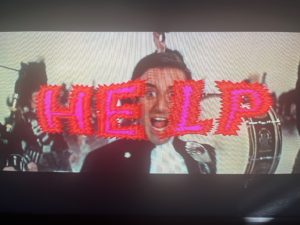 However, both plots reach their highest, as well as their lowest, moments when they embrace the surreal comedy ethos. Arguably this started with The Goon Show, of which Sellers was a key member, before really finding its home with audiences in the Sixties. Current examples of this genre include What’s New, Pussycat?, Round The Horne, the Dadaist stylings of the Bonzo Dog Doo-Dah Band and At Last the 1948 Show. The trend is gaining strength: reportedly Paul McCartney is also a fan and is keen to adopt fantastical elements into Beatles films. So it’s not surprising, given the involvement of Sellers and Feldman, that Casino Royale would be taken in such a direction.
However, both plots reach their highest, as well as their lowest, moments when they embrace the surreal comedy ethos. Arguably this started with The Goon Show, of which Sellers was a key member, before really finding its home with audiences in the Sixties. Current examples of this genre include What’s New, Pussycat?, Round The Horne, the Dadaist stylings of the Bonzo Dog Doo-Dah Band and At Last the 1948 Show. The trend is gaining strength: reportedly Paul McCartney is also a fan and is keen to adopt fantastical elements into Beatles films. So it’s not surprising, given the involvement of Sellers and Feldman, that Casino Royale would be taken in such a direction.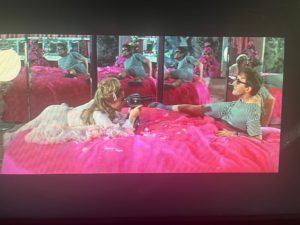 The picture’s surreal comedy doesn’t always work. For instance, there’s an annoyingly self-indulgent sequence which seems just an excuse for Sellers to dress up as historical characters. Others are better: Niven’s Bond, for instance, lives on an estate guarded by a pride of lions (“I did not come here to be devoured by symbols of monarchy!” protests the Soviet head of espionage), and the idea James Bond and Mata Hari had a relationship is a somehow appropriate melding of the archetypes of the male and female spy. Mata Bond stops the auction of Le Chiffre’s compromising photos by switching the projector to a war film: as if triggered, the British, American, Chinese and Russian representatives instantly all start fighting each other, in a comment on the Cold War worthy of
The picture’s surreal comedy doesn’t always work. For instance, there’s an annoyingly self-indulgent sequence which seems just an excuse for Sellers to dress up as historical characters. Others are better: Niven’s Bond, for instance, lives on an estate guarded by a pride of lions (“I did not come here to be devoured by symbols of monarchy!” protests the Soviet head of espionage), and the idea James Bond and Mata Hari had a relationship is a somehow appropriate melding of the archetypes of the male and female spy. Mata Bond stops the auction of Le Chiffre’s compromising photos by switching the projector to a war film: as if triggered, the British, American, Chinese and Russian representatives instantly all start fighting each other, in a comment on the Cold War worthy of  Furthermore, the surrealist aspect transforms some of the problems and conflicts that arose during its production, from potential flaws to part of an overarching psychedelic atmosphere. Orson Welles had apparently insisted on performing magic tricks on camera, but these become both a send-up of the contrived “eccentricities” of spy-series villains and a deeper comment on illusion and artifice. The title sequence, which starts out as a simple riff on Bond films’ animated credits, becomes increasingly disconcerting, the imagery including walls of eyes staring pitilessly out at the viewer, with connotations of surveillance and voyeurism.
Furthermore, the surrealist aspect transforms some of the problems and conflicts that arose during its production, from potential flaws to part of an overarching psychedelic atmosphere. Orson Welles had apparently insisted on performing magic tricks on camera, but these become both a send-up of the contrived “eccentricities” of spy-series villains and a deeper comment on illusion and artifice. The title sequence, which starts out as a simple riff on Bond films’ animated credits, becomes increasingly disconcerting, the imagery including walls of eyes staring pitilessly out at the viewer, with connotations of surveillance and voyeurism.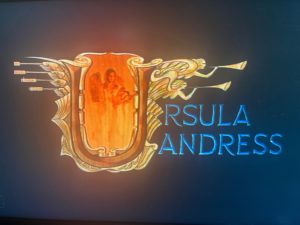 At the climax, the presence of multiple James Bonds escalates into a scenario where literally everyone becomes the titular hero; and this, together with the recurrence of doubles and duplicates, poses serious questions about how we construct our identity in modern society. At the end, everyone dies, going to Heaven or Hell, the accompanying random images and cheery music underscoring that there can be no guaranteed rescue or happy-ever-after in the atomic age.
At the climax, the presence of multiple James Bonds escalates into a scenario where literally everyone becomes the titular hero; and this, together with the recurrence of doubles and duplicates, poses serious questions about how we construct our identity in modern society. At the end, everyone dies, going to Heaven or Hell, the accompanying random images and cheery music underscoring that there can be no guaranteed rescue or happy-ever-after in the atomic age.
![[March 31, 1964] 7 Faces and 7 Places (The movie, <i>7 Faces of Dr. Lao</i>)](https://galacticjourney.org/wp-content/uploads/2019/03/640331a7_Faces_of_Doctor_Lao_.jpg)







